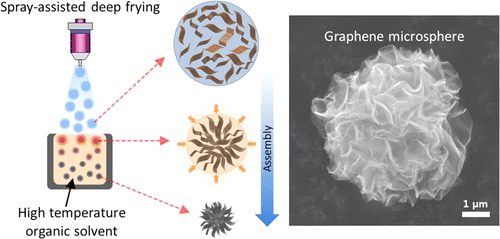Materials scientists from South Korea have managed to construct round, pom-pom-like graphene micro particles by spraying graphene oxide droplets into a hot solvent.

The process is similar to deep-frying and provides a very simple, but very versatile means to make electrode materials for batteries and super capacitors. The expected end result is devices with improved energy and power densities.
“To take full advantage of graphene in macro scale devices, it is important to integrate two-dimensional graphene nanosheets into a micro/macro sized structure that can fully utilise graphene’s nanoscale characteristics. To this end, we developed a novel spray-assisted self-assembly process to create a spherically integrated graphene microstructure (graphene microsphere) using a high-temperature organic solvent in a manner reminiscent of deep-frying,” the researchers state in their article titled “Spray-Assisted Deep-Frying Process for the In Situ Spherical Assembly of Graphene for Energy-Storage Devices”.
“This graphene microsphere improves the electrochemical performance of super capacitors, in contrast to no assembled graphene, which is attributed to its structural and pore characteristics. Furthermore, this synthesis method can also produce an effective graphene-based hybrid microsphere structure, in which Si nanoparticles are efficiently entrapped by graphene nanosheets during the assembly process.”
Graphene has been quite popular among scientists due to its excellent conductivity and stability, however the standard production techniques result in a thin film that tends to stack when aggregated which reduces the overall surface area and causes production difficulties.
The aim of this research is to create 3D clusters of graphene in order to maximise the surface area.
Sang-Hoon Park, a materials scientist at Yonsei University and his colleagues managed to create spheres of material composed of nanosheets of graphene that radiate out from the centre. This arrangement exposes more surface area and creates open nanochannels that can enhance charge transfer.
One of the major advantages of this new battery technology is its consistency and scalability for industrial applications.
“When used in a Li-ion battery, this material can provide a more suitable framework to buffer the considerable volume change that occurs in Si during electrochemical lithiation/delithiation, thereby improving cycling performance. This simple and versatile self-assembly method is therefore directly relevant to the future design and development of practical graphene-based electrode materials for various energy-storage devices,” the scientists state.




















